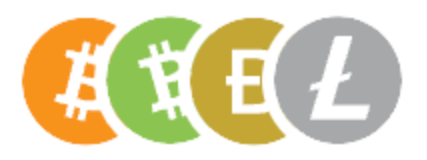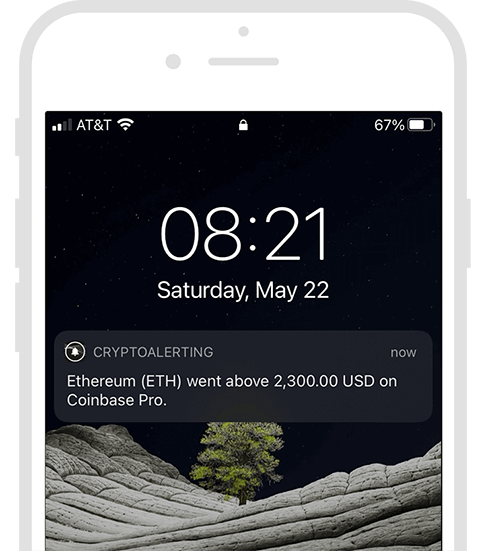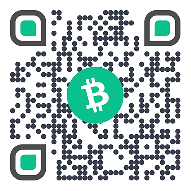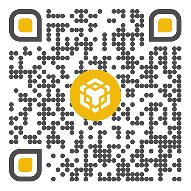Bitcoin
Bitcoin is the first successful and widely used implementation of a blockchain, originally proposed by Satoshi Nakamoto. It's a peer-to-peer payment system and store of value. Bitcoin can refer to both the tradable asset as well as the underlying protocol and technology.Our platform supports free BTC price alerts, percentage price alerts, BTC wallet monitoring and mempool size alerts.
 0x (ZRX)
0x (ZRX)
0x is an open, permissionless protocol allowing for ERC-20 tokens to be traded on the Ethereum blockchain. It offers a cheaper and faster solution than possible on the Ethereum blockchain directly, and is often used to help build DEXs. Users place their orders off-chain, which removes the need to pay fees. Only the actual transfers of value occur on-chain. Relayers broadcast all the off-chain orders of the 0x network to the rest of the network to match buyers with sellers. 0x is already being used by a number of blockchain projects. Aave (AAVE)
Aave (AAVE)
Aave (AAVE) is the native cryptocurrency of the Aave platform: an Ethereum-based DeFi lending platform where users can borrow a range of cryptocurrencies, as well as lend assets in exchange for interest payments, all without needing a middleman. The Aave protocol is governed by AAVE token holders. Algorand (ALGO)
Algorand (ALGO)
Algorand (ALGO) is both a digital currency and an open source blockchain platform. Their platform is designed for quick transaction processing, and can host other cryptocurrencies and blockchain-based projects, making it a direct competitor to Ethereum. ALGO, the platform's native currency, is used to secure the Algorand blockchain and pay processing fees for Algorand-based transactions. The total supply of ALGO is capped at 10 billion coins, with about 7 billion ALGO already circulating. Ark (ARK)
Ark (ARK)
Ark aims to create an ecosystem of linked blockchains using a technology called SmartBridge -- which allows existing blockchains to interface with one another. This altcoin uses a Delegated Proof of Stake (DPoS) consensus system originally developed by Bitshares. It features 8 second block times, making transactions nearly instantaneous. Several founders are the key developers behind Lisk. Augur (REP)
Augur (REP)
Augur is a decentralized prediction market built on top of Ethereum. A prediction market allows for forecasting the outcomes of arbitrary future events (such as who will win an election, or if an earthquake will hit a given city, etc). Reputation is an important part of Augur's success. By having a mechanism that incentivizes honest reporting by coin holders, Augur is able to operate with significantly lower fees than a centralized betting platform. Vitalik Buterin is an advisor. Avalanche (AVAX)
Avalanche (AVAX)
AVAX is the native token of the Avalanche blockchain, which uses smart contracts to support a variety of blockchain projects. Avalanche is a competitor to Ethereum that prioritizes scalability and transaction processing speed. The Avalanche blockchain can provide near-instant transaction speeds. AVAX is used to pay transaction processing fees, secure the Avalanche network, and act as a basic accounting unit for blockchains in the Avalanche network. Axie Infinity (AXS)
Axie Infinity (AXS)
Axie Infinity Shards (AXS) are an ERC-20 governance token for the Axie Universe. Axie Infinity is an online game universe revolving around Pokémon-esque creatures known as Axies. Players can collect Axies as virtual pets with aspirations to battle, breed, collect, raise, and build kingdoms for their Axies. AXS is the native currency to the game, and holders can claim rewards if they stake tokens, play the game, and participate in key governance votes. Basic Attention Token (BAT)
Basic Attention Token (BAT)
BAT aims to be a decentralized and transparent digital ad exchange. Rather than paying middleman companies like Facebook and Google to run ads, that money can be paid directly from advertisers to users in BAT tokens. Users can then turn around and use that BAT to pay their favorite content providers. Users retain ownership of their browsing data and allow for machine learning algorithms to match that data with relevant ads, without having it tied to your identity. Notably, BAT raised their ICO in under 30 seconds. Brendan Eich, the creator of JavaScript and co-founder of Mozilla and Firefox, is the primary figurehead. It already works with the privacy-focused Brave browser. Binance Coin (BNB)
Binance Coin (BNB)
BNB is a cryptocurrency that is used primarily to pay transaction and trading fees on the Binance exchange, but it can now be used for other types of transactions as well. It was originally based on the Ethereum network but is now the native currency of Binance's own blockchain, the Binance chain. Every quarter, Binance uses one-fifth of its profits to repurchase and permanently destroy, or "burn" BNB held in its treasury. Bitcoin Cash (BCH)
Bitcoin Cash (BCH)
A controversial hard fork of Bitcoin created in August 2017 as a reaction to SegWit being adopted. Bitcoin Cash attempts to solve scalability issues using larger block sizes in order to reduce transaction fees. It is derogatorily referred to as "bcash". Blocknet (BLOCK)
Blocknet (BLOCK)
Blocknet aims to be the "Internet of Blockchains". It claims to allow the features of one blockchain to function as a service accessible to users of every other cryptocurrency. Blocknet is a general-purpose infrastructure for inter-blockchain functionality, similar to Ark. Blockstack (STX)
Blockstack (STX)
Blockstack is building a decentralized internet where you can own your data and maintain your privacy. They are a platform to help enable developers to build decentralized applications (dapps) through the Blockstack Browser. Cardano (ADA)
Cardano (ADA)
Cardano aims to solve a number of issues that Ethereum reportedly suffers from. It has a multi-tiered architecture, where one layer is focused on transactions and accounts and the other layer is for smart contracts. This allows for easier upgrades and enhanced flexibility. It plans to feature on-chain governance, including a treasury where the community can then vote on how to fund the competition. It uses a Proof of Stake system called Ouroboros. Chainlink (LINK)
Chainlink (LINK)
Chainlink is offering a solution to the Oracle problem: It allows smart contracts to be connected to real world data & APIs. It essentially bridges the gap between on-chain information and off-chain information. It was founded by Sergey Nazarov, and has already garnered support from Google, IBM and other high profile institutions. Chia (XCH)
Chia (XCH)
Chia Network (XCH) is a layer 1 blockchain that aims to be a sustainable approach to blockchain technology with a smart transaction platform. It uses its own custom-designed programming language called Chialisp and a novel consensus mechanism called proof-of-space-and-time (PoST). The combination of these allows the blockchain to use less energy without compromising network security. Chia Network's blockchain endeavors to be a global open-sourced, decentralized network that operates a payment settlement system using Chia (XCH), their native cryptocurrency. Chiliz (CHZ)
Chiliz (CHZ)
The Chiliz token (CHZ) is the native cryptocurrency of the Chiliz network, which allows users to purchase Fan Tokens on Socios.com. This provides the option to buy tokenized voting rights in their favorite football and e-sports teams. CHZ initially launched as an Ethereum-based ERC-20 token, but also began offering Binance Smart Chain BEP-2 versions of the token following a strategic partnership with Binance. Civic (CVC)
Civic (CVC)
Civic is a decentralized identity ecosystem, where a user or company can request to verify the identity of another in a safe and cost-effective way that isn't tied directly to their personal information. For example, a user can use Civic to verify with a company that they are a US citizen without providing said documents to that company directly. Vinny Lingham is the CEO. Compound (COMP)
Compound (COMP)
Compound is a decentralized, blockchain-based protocol that allows you to lend and borrow crypto. Lenders earn interest on the assets they deposit and have a say in its governance with its native COMP token. Cosmos (ATOM)
Cosmos (ATOM)
Cosmos is a proof-of-stake blockchain, powered by its native ATOM cryptocurrency. The Cosmos Hub is the first of the interconnected blockchains that will eventually comprise the Cosmos Network. Cosmos aims to create a network of crypto networks united by open-source tools for streamlining transactions between them. Cosmos's goal is to foster an ecosystem of networks that can share data and tokens programmatically, with no central party facilitating the activity. Cronos (CRO)
Cronos (CRO)
Cronos is the official coin of Crypto.com, a cryptocurrency exchange that supports trading, investing, staking, wallets, NFTs, and more. Crypto.com supports over 250 different currencies and offers discounts for those who hold a significant stake in CRO. It was originally named after the exchange, but later rebranded to Cronos. Curve (CRV)
Curve (CRV)
Curve DAO is an Ethereum token that powers Curve.fi, a decentralized exchange and automated market maker protocol. The protocol is designed to make it easy to swap between similar ERC-20 tokens, especially stablecoins and Ethereum-based Bitcoin tokens. The CRV token can be bought or earned through yield farming — when you deposit assets into a liquidity pool and earn tokens as a reward. DASH (formerly XCoin and Darkcoin) (DASH)
DASH (formerly XCoin and Darkcoin) (DASH)
Short for "Digital Cash", this project aims to be a user-friendly payment system. It offers instant transactions (InstantSend), private transactions (PrivateSend) and operates a self-governing and self-funding model that enables the Dash network to pay individuals and businesses to perform work that adds value to the network. Dash's decentralized governance and budgeting system makes it a decentralized autonomous organization (DAO). Dash uses a Proof of Stake consensus mechanism and utilizes a two-tier network. Certain network functions, such as creating new blocks, are handled by the miners. The second tier of the Dash network consists of "masternodes" which perform PrivateSend, InstantSend, and governance functions. Decentraland (MANA)
Decentraland (MANA)
Decentraland is a virtual reality platform powered by the Ethereum blockchain. Users can create, experience, and monetize content and applications within a virtual world that they themselves own. Decred (DCR)
Decred (DCR)
Short for "Decentralized Credit", Decred is a digital currency that uses a community-based governance model to determine the future of its blockchain protocol. The people who own Decred have a say in how it evolves. It uses a hybrid Proof of Work and Proof of Stake mining system to decentralize the decision-making process. Includes decisions such as whether or not the development team should work on a specific feature, turn on/off existing features, and how to best spend development funds. DFINITY (DFN)
DFINITY (DFN)
Dfinity aims to reduce the costs of cloud services by creating a decentralized "internet computer". District0x (DNT)
District0x (DNT)
District0x is a network of decentralized markets and communities. Anyone can create, operate, and govern their own district. District0x is powered by Ethereum, Aragon, and IPFS. Dogecoin (DOGE)
Dogecoin (DOGE)
Originally created as a joke referencing the Shiba Inu dog meme, Dogecoin has gone on to reach heights of a 1 billion dollar market cap. It has become a popular coin to tip people over the internet. Dogecoin is a fork of Litecoin. Dogelon Mars (ELON)
Dogelon Mars (ELON)
ELON is a doge-themed token project aiming to replicate the success of Dogecoin (DOGE) while referencing Elon Musk's vision to colonize Mars. ELON claims to be the first interplanetary currency. It's an ERC-20 token built on the Ethereum blockchain. The founders of Dogelon Mars locked 50% of all the ELON liquidity in a Uniswap liquidity pool. Elrond (EGLD)
Elrond (EGLD)
The Elrond eGold (EGLD) token is native to the Elrond Network and is used for everything from staking, governance, and transactions to smart contracts and validator rewards. The Elrond blockchain focuses on providing easy integration solutions, scalability, high speeds, and low transaction costs. EOS (EOS)
EOS (EOS)
A smart contract platform comparable to Ethereum, notable for its year-long ICO. It offers significantly higher throughput (transactions per second), but only achieves this by being far less decentralized. Ethereum (ETH)
Ethereum (ETH)
Ethereum is a smart contract platform which allows decentralized applications to be written on the blockchain using a scripting language. In addition to simple wallet-to-wallet transactions, programs known as "contracts" can also send and receive funds based on programmable logic. This can be used to achieve many purposes, ranging from the creation of new tokens (ICOs), games like CryptoKitties, and replacing trusted third parties found in traditional finance. Ethereum was first proposed in a whitepaper by Vitalik Buterin in late 2013.Our platform supports free ethereum price alerts, percentage price alerts and ETH wallet monitoring.
 Ethereum Classic (ETC)
Ethereum Classic (ETC)
ETC refers to the original Ethereum blockchain. A hard fork created what we now call Ethereum on Jul 20th, 2016 due to a major hack known as the DAO incident. The DAO was a smart contract that was intended to work as a venture fund where contributors would get to vote on what projects/proposals get funded. 240 million dollars were raised. Somebody found an exploit in the code and managed to get around 3 million Ether out of the contract. A hard fork was made to return the ETH funds to the original DAO investors. Ethereum Name Service (ENS)
Ethereum Name Service (ENS)
Ethereum Name Service is a distributed and open naming protocol based on the Ethereum blockchain. It allows humans to use easy-to-remember domain names for their cryptocurrency addresses. The protocol then translates it to a machine-readable address. This process has many similarities to the DNS system used for the internet. ENS is the main governance token for the system. Users who hold ENS tokens gain voting rights via the network's DAO, and can use ENS tokens to pay fees. Fantom (FTM)
Fantom (FTM)
FTM is Fantom's native utility token and powers the entire Fantom blockchain ecosystem. FTM are used for staking, governance, payments, and fees on the network. Fantom blockchain is a fast, high-throughput open-source smart contract platform for digital assets and dApps. Filecoin (FIL)
Filecoin (FIL)
Filecoin is a decentralized file storage network made by Protocol Labs. They raised $52 million in a pre-ICO sale and an additional $200 million in their ICO. FTX Token (FTT)
FTX Token (FTT)
FTT is described as the "backbone" of the FTX exchange, which is an international crypto derivatives exchange. FTT tokens allow their users to get lower trading fee and access to certain perks on the FTX exchange. The tokens can also be used as collateral to trade derivatives. Gala (GALA)
Gala (GALA)
GALA is an Ethereum-based cryptocurrency that powers Gala Games, which is a platform that aims to revolutionize the gaming industry by giving players back control over their games. GALA is used as the medium of exchange between Gala Games participants. Gala Games is a blockchain-based, play-to-earn gaming platform. Players can also create and trade NFTs in the game. Golem (GNT)
Golem (GNT)
A token built on the Ethereum blockchain intended to create a marketplace for unused computer power. It aims to become an open source on-demand decentralized supercomputer network. With Golem, anyone will be able to rent their unused computing resources. Similarly, Golem will enable any user to buy computing time from other users to complete computationally demanding tasks. The Graph (GRT)
The Graph (GRT)
GRT is an Ethereum token that powers The Graph, a decentralized protocol for indexing and querying data from blockchains to facilitate information retrieval. With The Graph, anyone can build and publish open APIs, called subgraphs, making data easily accessible. Hedera Hashgraph (HBAR)
Hedera Hashgraph (HBAR)
Hashgraph is a distributed ledger technology that's been described as an alternative to blockchains. The hashgraph technology is currently patented, and the only authorized ledger is Hedera Hashgraph. The native cryptocurrency of the Hedera Hashgraph system is HBAR. Helium (HNT)
Helium (HNT)
HNT is the native token that powers the Helium network. HNT serves as a payout when Helium-connected hotspots transfer connection data across the network. Helium is a blockchain-based network for IoT devices that uses nodes as hotspots to connect wireless devices to the network. HEX (HEX)
HEX (HEX)
HEX is an Ethereum-based token that's marketed as the first blockchain certificate of deposit (CDs). HEX has taken the concept of CDs, added higher average return rates, removed banking fees and turned it into a decentralized cryptocurrency. Richard Heart launched Hex in 2019, utilizing an aggressive marketing campaign to build its user base. Users stake HEX tokens, promising to leave them untouched for specified amounts of time. ICON (ICX)
ICON (ICX)
ICON aims to connect different industries. ICON's platform is best thought of as a blockchain of blockchains. ICON consists of independently-governed blockchains that can function by their own rules but also work with each other. IOTA (MIOTA)
IOTA (MIOTA)
IOTA deviates from most cryptocurrencies in that it does not use a traditional blockchain. Instead it runs on a system called "The Tangle", which leverages a data structure called a directed acyclic graph (DAG) to create its distributed ledger protocol. This allows for free transactions of any size, without the need for miners or blocks. It is named after "Internet of Things", a buzzword envisioning a future where lots of small objects all around us are connected to the internet. Klaytn (KLAY)
Klaytn (KLAY)
KLAY is the native token that powers the Klaytn blockchain. Klay is used for all transactions that take place on the blockchain network and all other blockchain applications on the network. It mostly works as a means of payment and exchange for applications that run within the Klaytn ecosystem. Klaytn is a public blockchain designed for the metaverse, gaming, and the creator economy. Komodo (KMD)
Komodo (KMD)
Komodo began as a Zcash fork, and aims to provide anonymity through zero knowledge proofs and security through a Delayed Proof of Work (dPoW) protocol. It has gone on to form an ecosystem with additional functionalities like decentralized trading, atomic swaps and ICOs. Libra (LIBRA)
Libra (LIBRA)
Libra is a cryptocurrency developed internally at Facebook, designed to have a stable and reliable value. It is intended to be widely accepted around the world as a form of payment. Large organizations can join the Libra association by running a validator node on the network and serving in governance. While the token was originally designed to be backed by a pool of assets, it will instead resemble traditional stablecoins due to regulatory pressure. Go here to learn more about monitoring Libra. Lisk (LSK)
Lisk (LSK)
Lisk is a blockchain application platform where Dapps run on its own sidechains, and apps are written in JavaScript. Lisk has been integrated into Azure's Blockchain as a Service. Litecoin (LTC)
Litecoin (LTC)
An early fork of Bitcoin. It differs from Bitcoin in that it has a faster block time (2.5 vs 10 minutes), a larger maximum supply of coins and a different hashing algorithm (Scrypt, instead of SHA-256). The Script algorithm is memory-intensive rather than CPU intensive, which discourages the development of ASIC mining hardware. Loom Network (LOOM)
Loom Network (LOOM)
Loom Network allows for scalable Delegated Proof of Stake sidechains and DApps with the security of the Ethereum mainnet. They claim to offer the advantages of EOS but are built on Ethereum. Monero (XMR)
Monero (XMR)
A privacy-focused payment system where each transaction has the amount, the sender, and the recipient obscured. Monero is based on the CryptoNote protocol. Because of its privacy, Monero is fungible. The JavaScript implementation of Monero miner Coinhive has made it possible to embed the miner into a website to utilize website visitor's CPU to mine the cryptocurrency. Anonymity requires large resources, primarily memory: Monero transactions take up on average 8 times as much space as a Bitcoin transaction. NEAR Protocol (NEAR)
NEAR Protocol (NEAR)
Near Protocol is a layer 1 blockchain network. It provides a platform that developers can use to build decentralized applications (dapps). The most successful layer 1 blockchain is Ethereum, so protocols like Near are seen as challengers. Its native NEAR tokens are used to pay for transaction fees and storage on the Near crypto platform. NEM (XEM)
NEM (XEM)
NEM is a business focused cryptocurrency that is not meant to be used as a currency. It features a "Smart Asset System" which allows users to create custom blockchain solutions. Written in Java from the ground up, NEM uses unique methods of Proof of Importance (POI) and Delegated Harvesting to award coins (which uses far less power than traditional mining). It's a fully traceable, not private cryptocurrency. NEO (formerly Antshares) (NEO)
NEO (formerly Antshares) (NEO)
Often referred to as the "Chinese Ethereum", NEO is a smart contract platform. A second token, called "GAS" is used to pay for transactions, and is essentially a dividend paid to holders of NEO. NEO is notably one of the few cryptocurrencies that is not divisible (you cannot send/receive less than 1 NEO). OmiseGo (OMG)
OmiseGo (OMG)
OmiseGo aims to "Unbank the banked" by providing an array of payment services for individuals and businesses across Asia. It is a decentralized exchange and transaction platform centered in Southeast Asia. Notably, it already has a partnership with McDonald's Thailand. It's the first Ethereum-based project to exceed a $1 billion USD marketcap. Designed by the creator of Lightning Network and Plasma, Joseph Poon. Vitalik Buterin is a lead advisor. Optimism (OP)
Optimism (OP)
Optimism is a Layer-2 blockchain built on top of Ethereum, meant to have significantly lower fees and produce faster transactions. It uses "optimistic rollups" to speed up transactions and achieve a higher throughput than its parent chain. OP is the token that governs the Optimism blockchain. Orchid (OXT)
Orchid (OXT)
OXT is an Ethereum token that powers the Orchid network, a peer-to-peer privacy tool that includes a decentralized VPN and other features designed to give users more control over their Internet connection. OXT can be used to pay for bandwidth or staked by bandwidth providers in order to operate a node. PancakeSwap (CAKE)
PancakeSwap (CAKE)
The PancakeSwap token CAKE is a BEP20 token that originally launched on Binance Smart Chain. The main function of CAKE is to incentivize the liquidity to the PancakeSwap platform. Users can stake CAKE to earn rewards. Polkadot (DOT)
Polkadot (DOT)
Polkadot is a platform that allows diverse blockchains to transfer messages, including value, in a trust-free fashion; sharing their unique features while pooling their security. Polygon (MATIC)
Polygon (MATIC)
Polygon is a cryptocurrency as well as a technology platform that enables blockchain networks to connect and scale. Considered to be “Ethereum's internet of blockchains”, it operates as a Layer-2 on the Ethereum blockchain, and connects Ethereum-based projects. Polygon uses a modified proof-of-stake consensus mechanism that enables consensus to be achieved with every block, rather than requiring many blocks to achieve consensus. This method requires network participants to stake their MATIC, in exchange for the right to validate Polygon network transactions. Successful validators are rewarded with MATIC. Raydium (RAY)
Raydium (RAY)
Raydium is an Automated Market Maker (AMM) and liquidity provider built on the Solana blockchain for the Serum Decentralized Exchange. Users who provide liquidity to Raydium are incentivized with rewards in RAY, the utility token of the Raydium ecosystem. In turn, RAY can be staked in the platform to earn additional cryptos. By bringing together the flexibility of an AMM with the reliability of Serum's more traditional order book mechanism, Raydium supports the fast, liquid and low fee trading of digital assets on Solana with an additional source of liquidity. REN (REN)
REN (REN)
REN (previously Republic Protocol) is an Ethereum token that powers Ren's open protocol for transferring cryptocurrencies across different blockchains. Ren aims to bring popular assets like Bitcoin and Zcash to blockchains including Ethereum, making it possible for these assets to participate in a multi-chain decentralized finance ecosystem. Ripple (XRP)
Ripple (XRP)
Ripple is a real-time gross settlement system (RTGS) used by a number of traditional banks, although the degree to which banks are using their products is disputed. Some argue that it is not a cryptocurrency at all, given that it is highly centralized and is controlled/pre-mined by the company that created it. The Sandbox (SAND)
The Sandbox (SAND)
SAND is the token used throughout The Sandbox virtual metaverse, and is the basis for transactions and interactions, such as purchasing LANDS and ASSETS. SAND is an ERC-20 utility token built on the Ethereum blockchain. There is a finite supply of 3,000,000,000 SAND. Shiba Inu (SHIB)
Shiba Inu (SHIB)
Shiba Inu is an Ethereum-based altcoin that's widely considered to be an alternative to Dogecoin. Like Dogecoin, Shiba Inu is a meme coin featuring a Japanese breed of dog as its mascot. It was created in August 2020 by an anonymous individual or group called Ryoshi. Siacoin (SC)
Siacoin (SC)
Siacoin is a decentralized cloud storage platform. Sia stores data by splitting it into small fragments & encrypting it before distributing it across their network. People can rent out their unused harddrive space to earn money. Data is completely private: No one device has an entire file and all the files are copied on numerous devices (so if a harddrive fails your files won't be lost). Unlike centralized options like Dropbox, the market determines the price. Solana (SOL)
Solana (SOL)
SOL is the native token of Solana, a blockchain platform designed to host decentralized and scalable applications. Founded in 2017, Solana is an open-source project currently run by Solana Foundation based in Geneva, while the blockchain was built by San Francisco-based Solana Labs. SOL uses a proof of stake (PoS) blockchain and a new technology called proof of history (PoH). Solana is much faster in terms of the number of transactions it can process and has significantly lower transaction fees compared to rivals like Ethereum. Steem (STEEM)
Steem (STEEM)
Steem can be thought of as a decentralized version of Reddit where you can earn cryptocurrency when your content gets upvoted. It was cofounded by Daniel Larimer, who also founded Bitshares and EOS. SushiSwap (SUSHI)
SushiSwap (SUSHI)
Sushi (SUSHI) is an Ethereum token that powers SushiSwap's decentralized exchange. Sushi holders can participate in community governance and stake their tokens to earn some of SushiSwap's transaction fees, also known as gas. Stellar (XLM)
Stellar (XLM)
Stellar is an open-source, distributed payments infrastructure. It aims to facilitate multi-currency and asset transactions quickly and cheaply by using their native token (called Lumens) as a bridge. Cofounded by Jed McCaleb, who was founder of Mt. Gox and co-founder of Ripple. USD Coin (USDC)
USD Coin (USDC)
USDC is a tokenized U.S. dollar stablecoin, with the value of one USDC coin pegged 1:1 to the value of one U.S. dollar. Although it's not backed by a government and operates as an open-source project, USD Coin is fully backed by U.S. dollars or dollar-denominated assets like U.S. Treasury securities. USDC's reserve assets are held in segregated accounts with regulated U.S. financial institutions. The accounting firm Grant Thornton oversees these segregated accounts and provides monthly attestation reports. Tether (USDT)
Tether (USDT)
A stablecoin claimed by its creators to be backed by one dollar for each token issued. Its value is meant to be pegged to a dollar. It shares ownership with the Bitfinex exchange, and is based on the Omni Layer Protocol (and more recently, Ethereum as well). Tezos (XTZ)
Tezos (XTZ)
Tezos is a smart contract platform, like Ethereum, which aims to offer some standout features such as: on-chain governance, formal verification of contracts and Proof of Stake consensus. Theta Network (THETA)
Theta Network (THETA)
The Theta Token (THETA) is the governance token of the Theta protocol. Theta is a video and entertainment blockchain. The Theta blockchain provides end-to-end infrastructure for decentralized video streaming. Theta infrastructure enables existing video and media platforms to drive incremental revenues and reduce content delivery CDN costs while rewarding end-users for sharing their storage and/or bandwidth on any PC, mobile, Smart TV or IoT device. THORChain (RUNE)
THORChain (RUNE)
Rune is the base currency and the utility token of THORChain: a decentralized liquidity protocol that allows users to swap assets in a permissionless setting. It enables the exchange of native layer-1 assets like BTC by acting as a vault manager. This allows users to trade one digital asset on one chain with another digital asset on another chain in a decentralized, trust-minimized way. THORChain also allows anyone to earn yield on their digital assets. TRON (TRX)
TRON (TRX)
A decentralized protocol that aims to be a content distribution platform for the entertainment industry. The project envisions an ecosystem in which creators have the power to freely publish, store, and own their content. The network incentives users to build their own decentralized entertainment applications on top of it. Tron faced criticism for plagiarism in early 2018, because their whitepaper contains open source code from the Filecoin and IFPS whitepapers without citation. Uniswap (UNI)
Uniswap (UNI)
Uniswap is a decentralized exchange and UNI is the cryptocurrency it uses for governance. The Uniswap platform enables users to trade cryptocurrencies without any involvement with a centralized third party. This means it's available for anyone to use, and the platform has no ability to selectively restrict access. The Uniswap blockchain is hosted on the Ethereum platform and governed by UNI holders. Uniswap currently only supports the exchange of Ethereum-compatible cryptocurrencies. Waltonchain (WTC)
Waltonchain (WTC)
A platform aiming to help manage supply chains and improve the logistics of importing/exporting/warehousing small goods in China (and potentially elsewhere). It plans to use RFID chips along with their blockchain to help transparently track products along supply routes. Wrapped Bitcoin (WBTC)
Wrapped Bitcoin (WBTC)
WBTC is an Ethereum ERC-20 token that represents Bitcoin and can be swapped on a 1:1 basis for BTC. It's used in Ethereum's decentralized finance (DeFi) ecosystem. Being an ERC-20 token makes the transfer of WBTC faster than normal Bitcoin, but the key advantage of WBTC is its integration into the world of Ethereum wallets, decentralized apps (dapps), and smart contracts. yearn.finance (YFI)
yearn.finance (YFI)
YFI is an Ethereum token that governs the yearn.finance platform. Yearn.finance is a yield farming platform. Yield farming is a process of staking cryptocurrency to earn interest as passive income. Zcash (formerly ZeroCoin) (ZEC)
Zcash (formerly ZeroCoin) (ZEC)
Intended to be a version of Bitcoin that is more secure, faster, and support cross-chain transactions. It uses zk-SNARK for its privacy, which is later being adopted by Ethereum. It is controversially run by a private company, and 20% of its coins will ultimately be transferred to founders as rewards. Due to its anonymity, Zcash is a fungible token. Zilliqa (ZIL)
Zilliqa (ZIL)
Zilliqa is a high-throughput public blockchain platform designed to scale to thousands of transactions per second.Price Alert
Get notified when a coin goes above or below a price target.
Percentage Price Alert
Get notified when a coin changes in value by a specific percent.
We currently monitor ##### cryptocurrencies for realtime percent-change price alerts.
Choose from 9 different ways to get crypto alerts, including Slack, Telegram and Discord.
Realtime price monitoring across ## exchanges including Coinbase, Binance and BitMEX. Don't miss the next price breakout!
Cooldown:
Looking for an additional feature?
Coin Listing Alert
Get notified when a new coin is listed on an exchange.
Be the first to know when a new coin is listed on an exchange. View our recent detections.
Choose from 9 different ways to get notified, including SMS, Telegram and our Discord bot.
We monitor ## exchanges for real-time listing detection, including Coinbase and Binance.
Looking for an additional feature?

 Dai (DAI)
Dai (DAI)



















